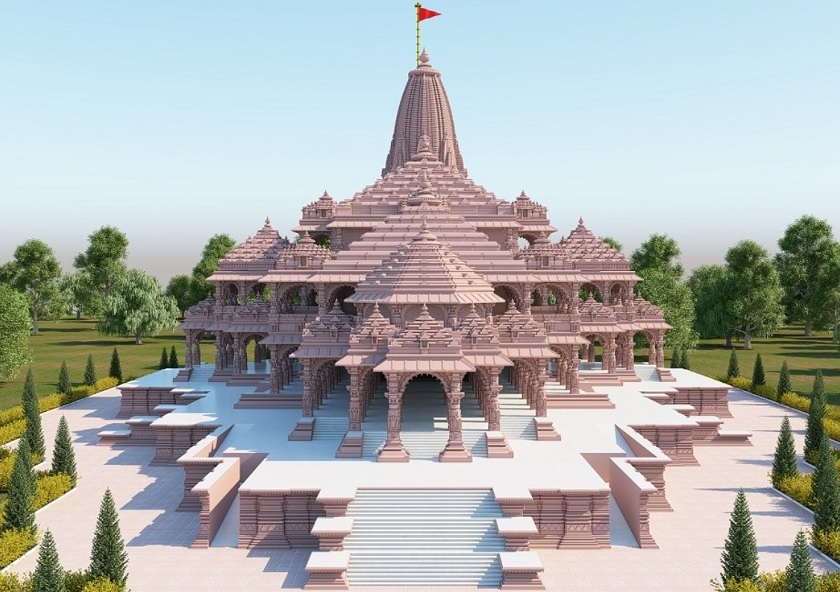Let us discuss some interesting facts about The Most Beautiful, Majestic and Biggest Ram Mandir Temple built in Ayodhya, Uttar Pradesh India. For the Hindu community in particular, the Ram Temple, also called the Ram Mandir, is of great cultural and religious significance in India. Millions of Hindus have long aspired for the temple’s construction, which is devoted to Lord Ram, a highly adored god in Hinduism. The intricate historical and legal path that is entwined with the story of the Ram Temple reflects the richness and complexity of India’s socio-religious milieu.
Historical Background
The Babri Masjid in Ayodhya, Uttar Pradesh, was constructed in 1528 by the Mughal emperor Babur, and this is when the origins of the Ram Temple controversy can be found. Since Lord Ram is thought to have been born in Ayodhya, the mosque’s building on this hallowed ground has caused controversy over the ages. After India gained independence in 1949, there were disagreements between the Hindu and Muslim communities over the appearance of Lord Ram idols inside the Babri Masjid. Court decisions trying to resolve the competing claims to the property resulted in legal disputes. One of the most polarizing topics in Indian politics and society today is the Ayodhya dispute.
Court Cases
Over several decades, the Ayodhya issue was the subject of court challenges. Hindus are now able to pray in the Babri Masjid after the district court ordered its gates to be opened in 1986. The Vishwa Hindu Parishad (VHP) then started a campaign in 1989 to construct a temple to Lord Ram at the disputed location. The Babri Masjid was demolished on December 6, 1992, by a sizable group of Hindu activists, including BJP and VHP members. Across India, this incident sparked intense communal strife and violence.

The Ayodhya Act and the Court Decision
The years that followed the demolition were characterized by court cases and attempts to reach a mutually agreeable resolution. In a historic ruling rendered in 2010, the Allahabad High Court divided the contested land into three portions: thirds went to the Sunni Waqf Board, third to the Nirmohi Akhara, and third to the group honoring the god Ram Lalla Virajman. Eventually, the matter made its way to the Indian Supreme Court, which heard lengthy arguments from all sides.
On November 9, 2019, the Supreme Court rendered a historic decision, awarding the god Ram Lalla Virajman possession of the entire contested property. The Sunni Waqf Board was given a five-acre block of land for the construction of a mosque by the court, which also ordered the government to establish a trust for the construction of the Ram Temple.
Establishment of the Shri Ram Janmabhoomi Teerth Kshetra
The Government of India established the Shri Ram Janmabhoomi Teerth Kshetra in February 2020 in accordance with the Supreme Court’s decree. The construction of the Ram Temple in Ayodhya was to be supervised by the trust. The Vishwa Hindu Parishad and the Nirmohi Akhara are two of the trust’s fifteen members.

The construction of the Ram Temple
August 5, 2020, marked the official start of the Ram Temple construction, with Prime Minister Narendra Modi and other dignitaries in attendance. The ceremony, which symbolized the realization of a lifelong ambition for many Hindus, marked a turning point in the cultural and religious landscape of India. The temple is meant to be a large building with elaborate carvings and sculptures, and its design is influenced by traditional Indian architecture. It is anticipated that the temple complex will have a large campus with a range of amenities for worshippers.
Worldwide Importance
The building of the Ram Temple in Ayodhya is a momentous occasion not only for India but the entire world. The issue’s historical, cultural, and religious ramifications have brought it international attention. The construction of the Ram Temple and the settlement of the Ayodhya conflict are examples of efforts to allay long-standing complaints and promote social peace.

Religious and Cultural Significance
The Ram Temple is very important both spiritually and culturally to millions of Hindus. It is said that Lord Ram was born in Ayodhya, and he is revered as a symbol of righteousness. Building the temple is interpreted as the restoration of Lord Ram’s divine presence at the location of his birth, denoting both the preservation of India’s cultural legacy and a cultural awakening.
Difficulties and Debates
Although many people are celebrating the Ram Temple’s construction, there have also been discussions and disputes around it. The Supreme Court’s ruling, according to some detractors, did not sufficiently address the historical injustice of the Babri Masjid’s demolition. Some raise worries on the possible effects on India’s secular fabric, highlighting the necessity of maintaining unity within a heterogeneous and varied society.

In summary
The building of the Ram Temple in Ayodhya represents a pivotal point in the socio-religious history of India. It depicts the intricate relationships between historical accounts, judicial rulings, and cultural goals. In the process of taking shape, the temple represents both faith and the application of the law; it is hoped that this would help to promote unity and understanding among India’s many communities. In addition to being a physical building, the Ram Temple symbolizes the rich fabric of religious and cultural diversity in India.
